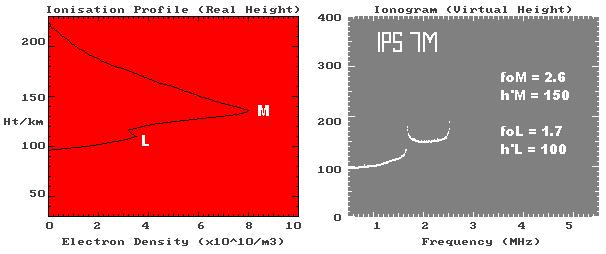A Martian Ionogram
The European Space Agency MARS EXPRESS spacecraft carried a number of experiments including an ionospheric topside sounder called MARSIS (Mars Advanced Radar for Subsurface and Ionospheric Sounding). In 2005, the first topside ionogram for Mars was published. Radio occultation measurements have been taken by a number of spacecraft, and from these, electron density profiles of the Martian ionosphere have been constructed. In an occultation experiment the radio signal from the spacecraft to the Earth passes through different layers of the planetary atmosphere as the spacecraft orbits behind the planet.
From these profiles it is relatively easy to compute what an ionogram from a Mars surface ionosonde would look like. The figures below show a daytime electron density profile (March 1999 at 74 degrees north) from the Mars Global Surveyor mission together with the computed ionogram.

The critical frequencies for the two layers are indicated on the ionogram, and as expected from the lower Martian electron densities, the frequencies are lower than their terrestrial counterparts. In the night-time, the lower layer mostly disappears and the higher layer increases in altitude and decreases in density, just as does on Earth. On Mars, the most significant ionospheric ion appears to be O2+.
As Mars has no global magnetic field, no magneto-ionic splitting or "O/X" separation of the upper trace is shown. However, regional remnant magnetic fields have been detected that are believed to originate from the regolith (surface layer), and it is possible that above these areas magneto-ionic splitting may occur. This would not be visible in a conventional ionogram because the maximum fields observed are less than 500 nT, which corresponds to a splitting separation of 7 kilohertz, only one hundredth of the typical separation on Earth.
It has been suggested that MF/HF radio might be a more economical solution for Martian surface communication than relay satellites, and that such communication may provide better coverage for deep rift valleys. However, some now suspect that strong ionospheric absorption, which could persist into the night sector, might make such radio communication unusable.
Material prepared by John Kennewell and Andrew McDonald.




